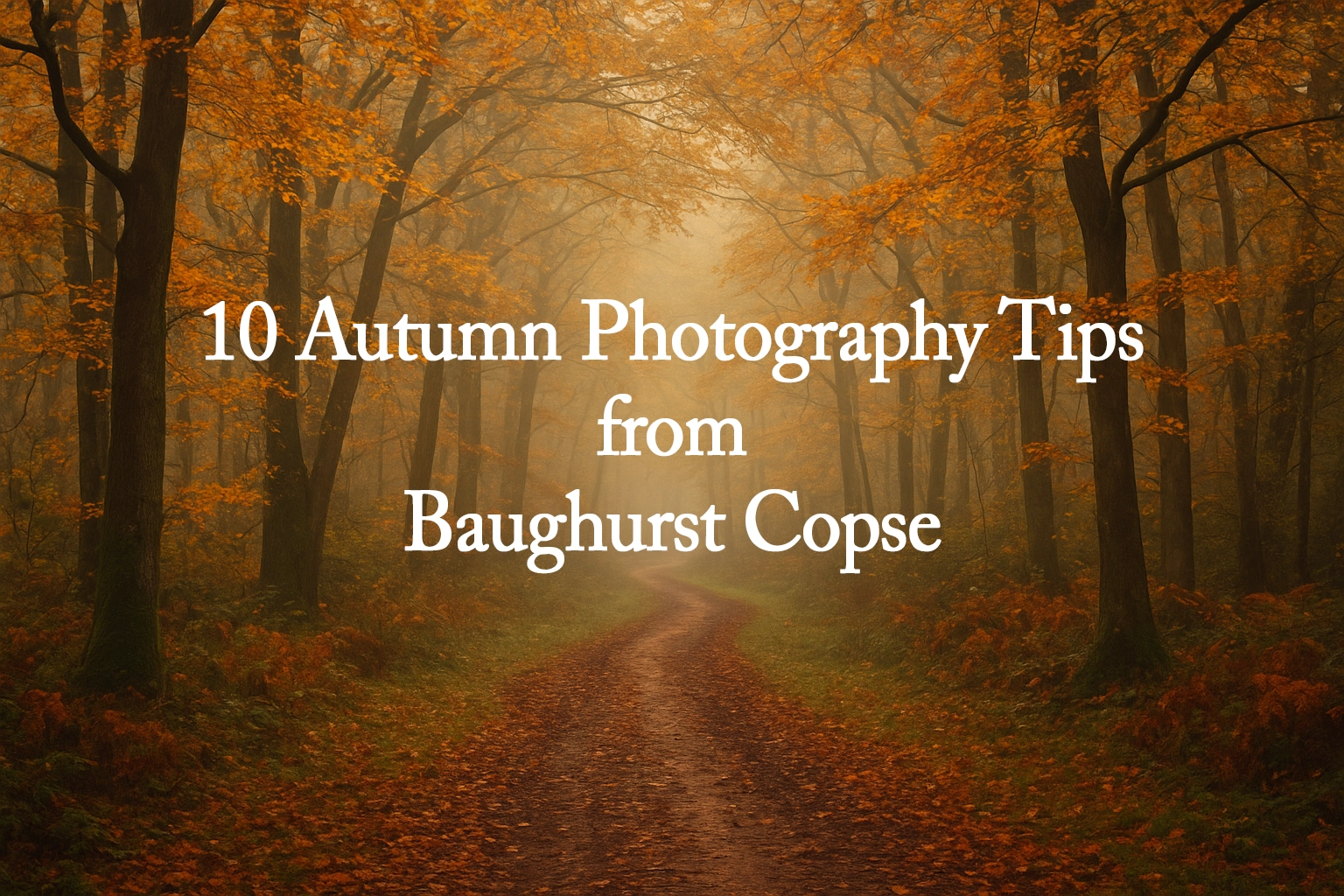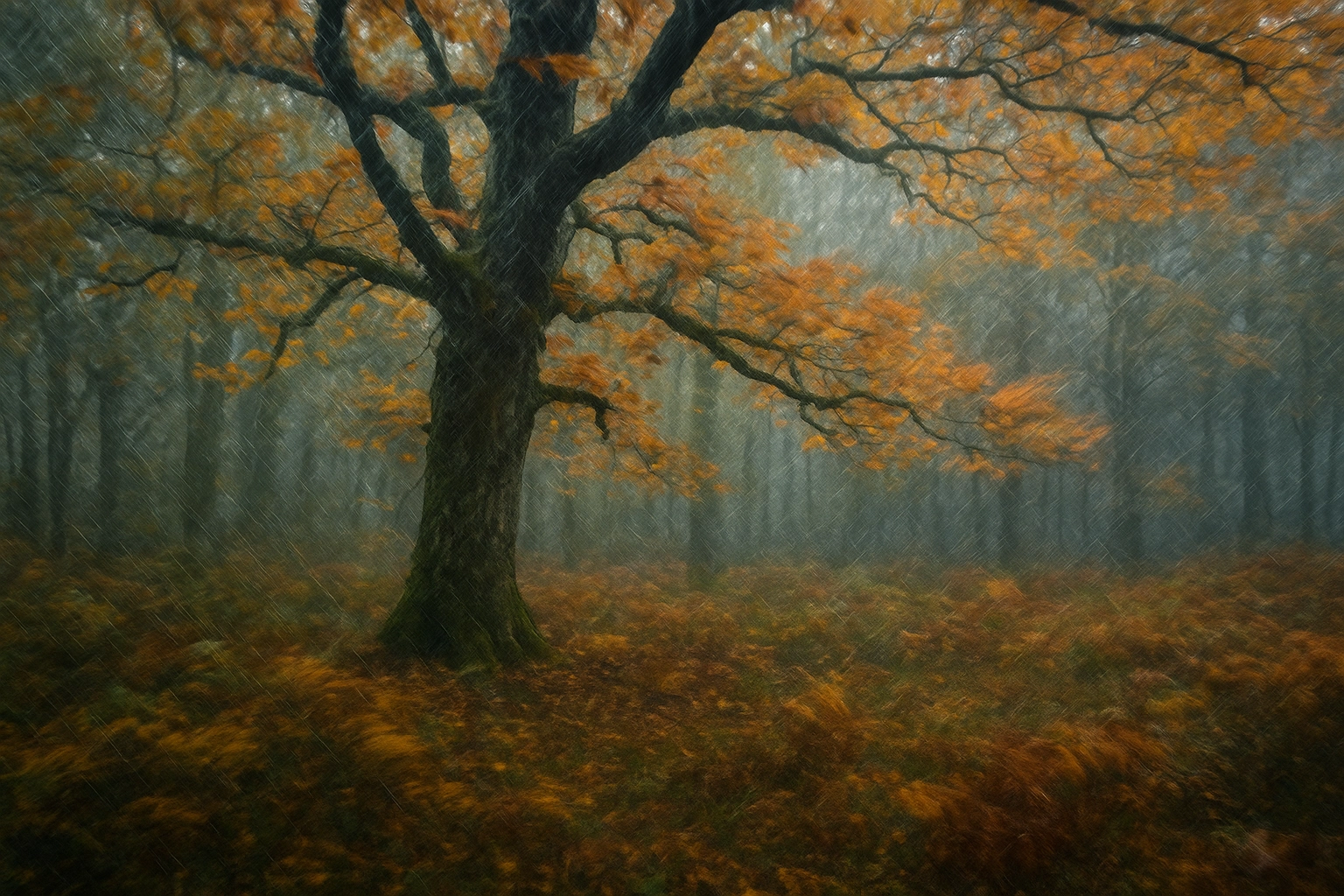
10 Autumn Woodland Photography Tips from Baughurst Copse
Autumn comes softly here, beneath the canopy of Great Haughurst Copse — a season stitched together from wind, woodsmoke, and the slow drift of colour through the trees. In autumn woodland photography, the mornings are filled with movement: deer slipping through wet bracken, jays cracking acorns in the hush before rain. Each path feels alive, expectant, as though the land itself is turning a page. These are the days when the camera becomes less a tool and more a companion — a way to listen, to breathe with the weather, to notice how light and life keep remaking the same place anew.
The storm has been restless since dawn. Wind presses against the hedgerows, leaves scatter across the lanes, and the woods at Baughurst Copse seem alive — whispering, sighing, rearranging themselves for autumn’s great performance.
Table of Contents
ToggleThese are the days when autumn photography reveals its real magic: not in postcard colour, but in weather, texture, and mood. Capturing the season isn’t about perfect light — it’s about feeling what the land is saying and letting that guide your camera.
Below are ten field-tested tips for autumn landscape and woodland photography, drawn from long walks through the North Hampshire countryside and quiet mornings spent watching the trees change.
1. Let the Weather Lead the Way in Mindful Photography
Storms transform familiar places. Rain deepens the tones of bark, ivy, and lichen, while gusts animate the canopy into a living thing. Instead of waiting for calm, step into it. Use the conditions to tell a story — let motion blur become part of your image.

Try slower shutter speeds (1/10 or 1/20 sec) to paint movement into branches or long grass. The trick is to brace yourself, breathe steadily, and release the shutter between gusts. Stormy weather photography often carries more energy than any still, sunny frame.
2. Learn the Language of Trees
Understanding local woodland species helps you predict when autumn peaks. Around Baughurst Copse, the silver birchand rowan begin their transformation first, glowing gold in early October. Beeches shift next, through soft amber into deep copper, while oaks hold their green until nearly winter.
Photographing trees as individuals rather than as a mass helps capture personality — their bark, branch shape, and even the tone of their fallen leaves. That’s the poetry of woodland photography: learning to see trees not as background, but as characters.
3. Chase the Fog, Not the Sun
If you’re lucky enough to wake to fog after a storm, grab your camera and go. Mist turns ordinary paths into scenes of mystery, muting distractions and revealing layers of depth.
To find fog, check the dew point — if the air temperature and dew point are within one degree, fog is likely. Low-lying areas around the lanes near Silchester Road or the fields south of Baughurst Copse often collect it first. These quiet, early hours are where fog photography becomes deeply meditative — each step revealing and concealing in equal measure.
4. Photographing Autumn Colours and The Ground is as Beautiful as the Canopy
Autumn Woodland Photography isn’t only about grand landscapes. The forest floor, slick with rain, is a canvas of texture: fallen leaves, acorns, moss, and fungi. Bring a macro lens or use your 105mm at a lower angle.

Look for repeating shapes, spirals, or contrasts in decay and renewal. A single leaf half-buried in mud can speak more about autumn’s truth than a whole forest on fire with colour. Practise mindful photography here — slow down, breathe, and notice the overlooked details.
5. Use a Polarizing Filter After Rain
A polarizing filter is essential for woodland photography after rainfall. It reduces glare from wet leaves and enhances the depth of colour, giving beech woods a velvet richness. Rotate the filter slowly while looking through your viewfinder — you’ll see reflections vanish and colour saturate.
This is particularly effective when photographing under soft light or overcast skies, where contrast can otherwise feel flat. Think of the polarizer not as a technical tool, but as a painter’s brush — bringing subtle, natural clarity to the scene.
6. Work with the Wind Capturing Autumn Mood
Autumn gales are unpredictable, but you can use them creatively. When branches sway and bracken moves, try longer exposures or intentional camera movement (ICM). Move your camera gently upward during the exposure — it transforms the woodland into impressionistic streaks of tone and colour.
Experimentation is part of the mindfulness of creative autumn photography. You’re not capturing perfection; you’re capturing presence — your own response to the moment as the wind speaks through the trees.
7. Seek Natural Frames
Branches, trunks, and clearings can form organic frames for your subject. In Baughurst Copse, the curved limbs of beeches often create archways of light that feel like invitations into another world.
Framing adds depth, helps lead the viewer’s eye, and conveys a sense of shelter. It also invites you to slow down and observe — to find order in apparent chaos. That patience, too, is part of mindful landscape photography.
8. Balance Warmth in Post
On stormy days, the light can feel cold and grey. When editing, add warmth with subtle shifts in white balance — just enough to restore the emotional tone of the scene.

Film photographers can choose warmer emulsions like Kodak Portra or Ektar; digital shooters can adjust Kelvin temperature to taste. The aim isn’t to falsify the image, but to translate feeling into colour — the memory of the walk, not the measurement of light.
9. Don’t Forget the Soundscape
Though cameras can’t record sound, you can still photograph with your ears. Listen to the storm: rain striking bracken, branches bending, water running off bark. Let that rhythm guide your timing.
The act of listening keeps you grounded. It shifts photography from a hunt for images to a practice of attention — a mindful engagement with the moment, even when no picture is taken.
10. Leave Space for Chance
Some of the best photographs aren’t planned. After today’s storm, the clouds broke briefly — a pale beam of sun glancing through the dripping canopy. It lasted seconds.
Be ready, but not hurried. Keep your camera on, aperture pre-set, ISO steady. When light appears, respond instinctively. Autumn’s magic lies in ephemeral moments, and the joy of being there when they arrive.
Field Note
“After the storm passed, I stood by the edge of Baughurst Copse, boots sinking in wet leaves. Mist drifted through the trees, birds tentative in the silence. The air was thick with that clean, electric scent of rain. I didn’t make many photographs — but every frame I took felt alive.”
Autumn Photography Ideas Closing Thoughts
Autumn photography isn’t just about the camera; it’s about listening, waiting, and walking with awareness. Around North Hampshire, storms and fogs come and go, but their memory lingers in the hedgerows and the still pools under the trees.
Every photograph is a kind of gratitude — for weather, for light, for the quiet spaces between.
Stephen Paul Young
I’m Steve (Stephen Paul Young), a landscape, digital and film photographer with a deep love for capturing the beauty of nature, light, and atmosphere. Whether I’m out at dawn chasing the perfect sunrise, exploring woodland trails, or experimenting with black-and-white film, photography is my way of seeing the world. I’m drawn to the small details and the big vistas alike, always looking for that moment where light, texture, and emotion come together. For me, photography isn’t just about taking pictures—it’s about storytelling, connection, and the joy of being present in the landscape.
You May Also Like

Capturing Nature’s Drama on Ilford FP4 Film
26 May 2024
Kentmere Pan 200 Review: Brilliant Flexibility on a Budget
1 August 2025
